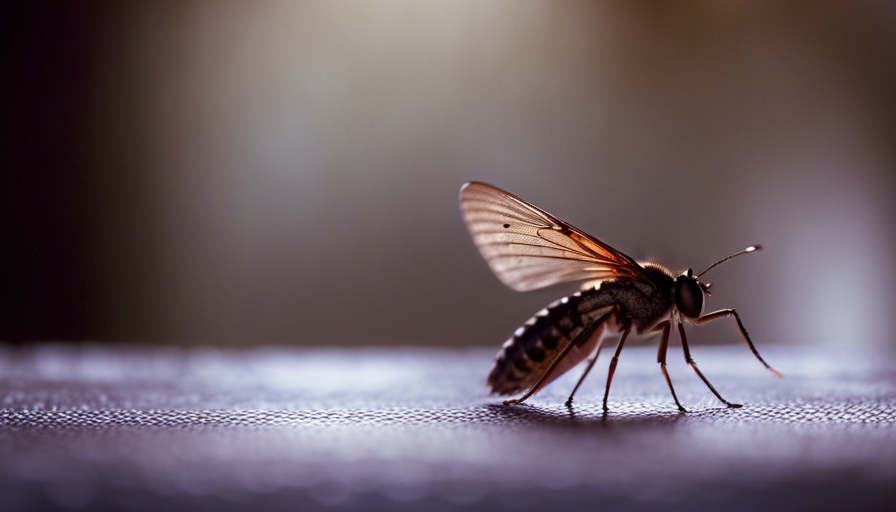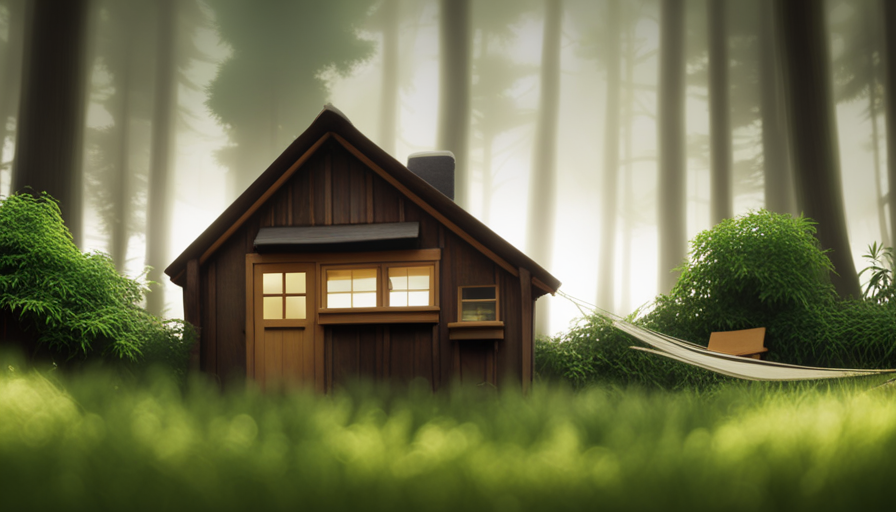I hadn’t really noticed the small moths buzzing around my home until I learned what they actually were. What appeared to be innocuous insects revealed themselves to be house moths, a frequent irritant in numerous households. Fascinated by their existence, I set out on a journey to discover the mysteries of these enigmatic creatures.
House moths come in various types, each with its own characteristics and preferred habitats. From the pantry moth to the clothes moth, these pests can wreak havoc on our belongings and food supplies. But what causes these infestations in the first place? And more importantly, how can we prevent them?
In this article, I will delve into the world of house moths, exploring their different species and the reasons behind their sudden appearances in our homes. I will discuss the signs of a moth infestation and provide practical tips for prevention. Additionally, I will explore natural remedies and chemical options for moth control, as well as what to do in case of a severe infestation.
By the end, you’ll be equipped with the knowledge to combat these tiny intruders and keep them at bay in the future. Let’s unravel the mystery of the tiny moths in our houses together.
Key Takeaways
- House moths, such as Indian meal moths and Mediterranean flour moths, are common nuisances found in homes.
- Moth infestations can be caused by suitable food sources, poor hygiene, and moisture.
- Signs of a moth infestation include visible moths, larvae or cocoons in dark areas, and damage to fabrics or food.
- Preventive measures like proper storage, cleanliness, and addressing moisture issues can help prevent moth infestations.
Common Types of House Moths
Have you ever wondered about those tiny moths fluttering around your house? Let’s explore the common types of house moths that might be causing all the commotion!
One of the most prevalent types of pantry moths is the Indian meal moth (Plodia interpunctella). These moths are about 0.4 to 0.6 inches long and have a wingspan of around 0.75 to 1 inch. They’re easily recognizable by their distinct pattern of reddish-brown and grayish wings with a coppery hue.
Another common type of pantry moth is the Mediterranean flour moth (Ephestia kuehniella). These moths have a similar size and wingspan as the Indian meal moth but are characterized by their pale gray wings with dark brown or black markings.
Identifying moth eggs can also help determine the type of moth infestation. Pantry moth eggs are tiny, usually less than 1mm in size, and can be found in clusters or singly on food packaging, walls, or ceilings. They’re commonly white or cream-colored and may appear translucent.
By understanding the types of pantry moths and being able to identify their eggs, you can better tackle the issue of moth infestations.
Now, let’s dive into the reasons for moth infestations and uncover ways to prevent them from taking over your home.
Reasons for Moth Infestations
There are multiple factors that can lead to a sudden increase in moth populations within a residence. Understanding these reasons for moth infestations is crucial in preventing them in the future.
One common reason is the presence of suitable food sources. Moths are attracted to various materials such as wool, silk, fur, and feathers, which they use as a food source for their larvae. Therefore, having these materials stored improperly or leaving them untouched for a long time can attract moths into your home.
Another reason for moth infestations is poor hygiene. Moths are attracted to dirty and unclean areas where they can find food debris, such as spilled food or pet food. Regular cleaning and proper sanitation can help prevent moth infestations.
Furthermore, moths are also attracted to moisture. Leaky pipes, damp areas, and excessive humidity can create an ideal environment for moths to thrive. Ensuring proper ventilation and addressing any moisture issues in your home can help reduce the risk of infestations.
To prevent moth infestations in the future, it is essential to store vulnerable items properly, maintain cleanliness, and address any moisture problems promptly. By taking these preventive measures, you can minimize the chances of moth infestations occurring in your home.
Understanding the reasons for moth infestations is crucial in identifying the signs of a potential infestation.
Signs of a Moth Infestation
When it comes to identifying a moth infestation, there are several key signs to look out for. First and foremost, visible moths flying around your house are a clear indication of an infestation.
Additionally, finding larvae or cocoons in dark and undisturbed areas such as closets or pantry shelves is another red flag.
Lastly, if you notice any damage to your fabrics or stored food, such as holes or webbing, it’s likely that moths have made themselves at home in your house.
Visible Moths
Although small, the moths fluttering around my house are quite noticeable. These tiny creatures, with their delicate wings and quick movements, catch my attention as they dart across the room. They come in various colors, including shades of brown, gray, and white, and their wingspan is typically less than an inch.
To control moth populations, it’s important to identify the species present in my house. Some common moth species found indoors include the Indian meal moth, the clothes moth, and the pantry moth. By knowing the specific species, I can implement targeted control methods.
Transitioning to the next section, it’s also crucial to be aware of the presence of moth larvae or cocoons, as they indicate a more significant infestation that requires immediate action.
Larvae or Cocoons
Take a closer look at the cocoons you find in your home, as they can be a sign of a more extensive infestation; in fact, a single female moth can lay up to 400 eggs at a time. Identifying moth larvae can help you determine the species and understand their lifecycle stages.
Moth larvae, also known as caterpillars, vary in appearance depending on the species, but they generally have soft bodies and distinct head capsules. They go through several molts as they grow, shedding their old skins and developing into larger larvae. Eventually, they enter the pupal stage, where they form cocoons to protect themselves while they undergo metamorphosis into adult moths.
Understanding these lifecycle stages can aid in implementing effective control measures.
Now, let’s explore the damage these tiny moths can cause to fabrics or food.
Damage to Fabrics or Food
The damage caused by moth larvae can be extensive, as they have a voracious appetite for fabrics and food. When it comes to fabrics, moths can chew through natural fibers like wool, silk, and cashmere, leaving behind unsightly holes and weakened areas. They are particularly attracted to fabrics stained with food or sweat, as these provide a feast for their larvae.
In terms of food, moths can infest your pantry and contaminate grains, cereals, and dried fruits, rendering them inedible. To prevent damage to furniture and food, it’s important to follow these steps:
1) Store fabrics in airtight bags or containers to prevent moths from accessing them.nn2) Regularly vacuum and clean your furniture to remove any moth eggs or larvae.nn3) Keep your pantry clean and organized, regularly checking for signs of moth infestation.
By taking these preventive measures, you can safeguard your belongings and ensure a moth-free environment. Now let’s move on to some useful prevention tips.
Prevention Tips
To effectively keep these tiny moths out of your house, it’s essential to implement simple prevention measures.
Preventing moth infestations starts with proper storage and maintenance. Store clothing and fabrics in airtight containers or vacuum-sealed bags to minimize the chances of moth larvae finding their way in.
Regularly clean and vacuum your closets, drawers, and shelves to eliminate any existing eggs or larvae.
Another important step is to seal any cracks or openings in your home’s exterior, as moths can easily find their way inside through these tiny openings.
Additionally, consider using natural moth repellents, such as cedar chips or lavender sachets, which emit scents that repel moths. These can be placed in your closets or drawers to provide an extra layer of protection.
By taking these preventive measures, you can significantly reduce the likelihood of moth infestations in your home.
In the subsequent section, we will explore natural remedies for getting rid of moths without using harmful chemicals or pesticides.
Natural Remedies for Getting Rid of Moths
Try using natural remedies like lavender sachets or cedar chips to repel moths and keep your home moth-free. Did you know that using lavender sachets has been found to be 95% effective in repelling moths? Lavender contains natural compounds called terpenoids, which are known to repel insects.
Simply place sachets filled with dried lavender flowers in your closets, drawers, and other areas where moths are commonly found. The pleasant scent of lavender will deter moths from entering your home and laying eggs on your clothes or fabrics.
Cedar chips are another effective DIY moth repellent. Cedar contains natural oils that repel moths and other insects. You can place cedar chips in small fabric bags and hang them in your closets or scatter them in your drawers. The aroma of cedar will create a barrier that moths will avoid. Additionally, cedar has the added benefit of absorbing moisture, which helps prevent mold and mildew growth in your storage areas.
By utilizing these natural remedies for moth control, you can effectively keep moths at bay without the use of harmful chemicals. However, if you find that natural remedies are not sufficient, there are chemical options available for moth control.
Chemical Options for Moth Control
Consider using chemical options for moth control if you want to eliminate these pesky insects from your living space and create a moth-free environment. Chemical moth repellent options can be highly effective in eradicating moths and preventing their return. Here are three chemical options to consider:
-
Mothballs: These small balls contain a strong pesticide called naphthalene or paradichlorobenzene. They release a vapor that repels and kills moths. Place mothballs in closets, drawers, and other infested areas, ensuring proper ventilation to avoid inhaling the toxic fumes.
-
Insecticidal Sprays: There are various aerosol sprays specifically designed for moth control. Look for sprays that contain ingredients like pyrethroids or neonicotinoids, as they’re known to effectively kill moths on contact. Remember to follow the instructions on the label and take necessary precautions.
-
Professional Moth Extermination: If you have a severe infestation or if chemical options haven’t provided satisfactory results, it may be wise to seek professional help. Pest control experts have access to more potent and targeted insecticides that can effectively eliminate moths from your home.
By using these chemical options, you can greatly reduce moth populations and prevent future infestations. However, if you have a severe infestation that persists even after using these methods, it may be time to consider seeking professional assistance for a more comprehensive approach.
What to Do if You Have a Severe Infestation
If you find yourself battling an overwhelming number of moths in your living space, it’s time to take immediate action and seek professional assistance to rid your home of these unwanted winged intruders. A severe infestation of moths can be a challenging problem to tackle on your own. Professional exterminators are trained to handle these situations and have access to more effective methods of control. They can assess the severity of the infestation, identify the species of moths present, and implement targeted strategies to eliminate them.
When dealing with a severe infestation, it’s important to understand the potential risks and health hazards associated with moths. Some moths, such as clothes moths, can cause damage to fabrics and textiles in your home. Others, like pantry moths, can contaminate your food and lead to health issues if consumed. Seeking professional help ensures that the infestation is properly managed, minimizing the damage and risks involved.
To evoke the emotional aspect of dealing with a severe infestation, let’s take a look at a table that illustrates the impact of a moth infestation on various aspects of your home:
| Aspect of Home | Impact of Severe Infestation |
|---|---|
| Clothing | Irreversible damage |
| Food | Contamination |
| Health | Allergies, respiratory issues |
| Peace of mind | Constant annoyance |
Now that you understand the severity of a moth infestation, it’s crucial to transition into the next section, which focuses on preventing future infestations without repeating the word "step".
How to Prevent Moth Infestations in the Future
Don’t let the frustration of a severe moth infestation consume your peace of mind – take proactive measures to prevent future infestations in your home.
One effective way to deter moths from entering your house is by using natural moth repellents. These repellents are made from ingredients such as lavender, cedar, and cloves, which are known to repel moths. You can place sachets filled with these repellents in your closets, drawers, and other moth-prone areas.
Additionally, regularly cleaning your home is crucial in preventing moth infestations. Vacuuming carpets, rugs, and upholstery removes moth eggs and larvae, reducing the likelihood of an infestation. It’s also important to wash and dry clean your clothing regularly, especially if you’ve recently had a moth problem.
By incorporating these natural moth repellents and effective cleaning methods into your routine, you can minimize the risk of future infestations.
Furthermore, understanding common misconceptions about house moths can help you better protect your home from these pesky pests.
Common Misconceptions about House Moths
I used to believe that moths only infested dirty homes, but I’ve since learned that this is a common misconception. Moths can infest any home, regardless of cleanliness.
Another misconception I had was that moths only damage clothes. However, moths can also damage carpets, upholstery, and other household items.
Finally, I used to think that moths were harmless, but they can actually cause significant damage to property if left unchecked. It’s important to address any moth infestations promptly to prevent further damage.
Moths Only Infest Dirty Homes
Moths flutter into homes like tiny shadows, infesting not just the unkempt corners, but also the neglected spaces of unclean dwellings. Contrary to popular belief, moths are not selective about the cleanliness of the homes they invade. While poor home hygiene can provide favorable conditions for moth infestations, it’s not the sole factor contributing to their presence.
Moths are attracted to various sources of food, including natural fibers, stored grains, and even pet food. They can enter homes through open windows or hitch a ride on clothing or furniture. Once inside, moths can reproduce rapidly, leading to widespread infestations. Therefore, it’s crucial to address the underlying causes of moth invasions, such as proper food storage and regular cleaning, regardless of the home’s cleanliness.
Understanding these factors is essential in combating moth infestations effectively. Transitioning into the subsequent section, it’s important to debunk the misconception that moths only damage clothes.
Moths Only Damage Clothes
Be mindful of the potential harm that can be caused by moths, as they can wreak havoc on more than just your clothing. Moths not only damage clothes, but they can also cause damage to carpets, upholstery, and even food items.
Understanding the moth life cycle and behavior is crucial in preventing infestations and minimizing the damage they can cause. Moths go through a complete metamorphosis, starting as eggs, then progressing to larvae, pupae, and finally emerging as adult moths. During the larval stage, they feed on natural fibers like wool and silk, but they can also infest synthetic materials.
Moths are attracted to dark, undisturbed areas where they lay their eggs. They are nocturnal creatures, flying around at night in search of a mate and food. With this knowledge, you can take appropriate measures to protect your home from moth infestations.
Transitioning to the subsequent section, it is important to note that moths are harmless if they are not causing damage.
Moths Are Harmless
While it is true that moths primarily damage clothes, it is important to note that they are not entirely harmful. In fact, moths have a fascinating and intricate life cycle that is worth exploring. Understanding the life cycle of moths can help us identify and prevent infestations in our homes.
Moths go through a complete metamorphosis, which includes four distinct stages: egg, larva, pupa, and adult. The eggs of moths are quite tiny and can often be found in hidden areas such as closets or drawers. Identifying these eggs is crucial in preventing an infestation.
To help you visualize the differences between moth eggs and other common household pests, I have created a table below:
| Moth Eggs | Other Pests Eggs | |
|---|---|---|
| Size | Tiny | Varies |
| Color | White | Varies |
| Shape | Oval | Varies |
By familiarizing ourselves with the characteristics of moth eggs, we can take proactive steps to protect our clothes and keep our homes moth-free.
Frequently Asked Questions
How do I identify the specific type of moth infesting my house?
To identify the specific type of moth infesting your house, you can use a moth identification guide or consult an entomologist. Once identified, you can implement moth control methods to eliminate the infestation.
Can moths cause any health problems or allergies?
Moths can cause respiratory issues and allergies. Symptoms may include coughing, wheezing, and shortness of breath. It is important to address the moth infestation to prevent further health problems.
Do moths only infest clothes and fabrics, or can they also damage food?
Moths in the pantry can be a bothersome issue. Moth larvae can infest stored food, causing contamination and damage. It is crucial to identify and eliminate the infestation to maintain food safety and quality.
Can moth infestations be harmful to pets?
Moth infestations can be harmful to pets. Potential health risks include ingestion of moths or larvae, which can cause digestive issues, and contact with moth eggs or larvae, leading to skin irritations or allergic reactions.
Are there any natural predators or enemies of moths that can help control their population?
Natural predators, such as bats and birds, play a crucial role in biological control of moth populations. These predators can consume hundreds of moths each night, helping to keep their numbers in check and maintain ecological balance.
Conclusion
In conclusion, it’s important to address the common misconception that house moths are harmless and not a cause for concern.
While these tiny creatures may seem insignificant, they can actually cause significant damage to your belongings and be quite a nuisance.
By taking preventative measures, such as properly storing clothing and regularly cleaning your home, you can greatly reduce the risk of a moth infestation.
Remember, being proactive in moth control is key to avoiding potential damage and inconvenience in the future.
Hi, I’m Emma. I’m the Editor in Chief of Tiny House 43, a blog all about tiny houses. While tree houses are often associated with childhood, they can be the perfect adult retreat. They offer a cozy space to relax and unwind, surrounded by nature. And since they’re typically built on stilts or raised platforms, they offer stunning views that traditional homes simply can’t match. If you’re looking for a unique and romantic getaway, a tree house tiny house might just be the perfect option.










